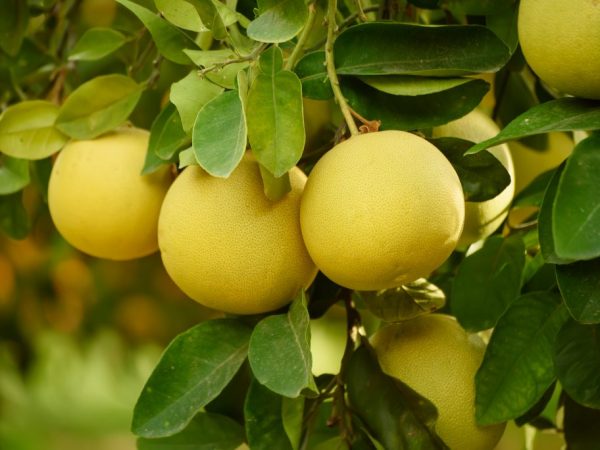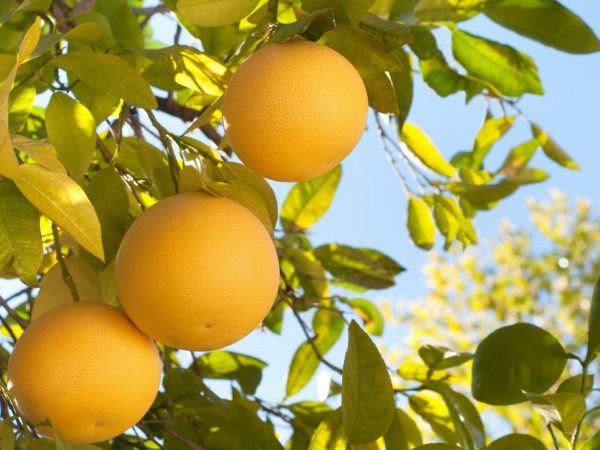Where does grapefruit grow and how to choose it
Grapefruit is one of the novelties of the citrus industry. Countries where citrus fruits are grown, on February 2, they celebrate the holiday of the grapefruit harvest. The record holder for the harvest is the island of Juventud in Cuba.

The origin of the grapefruit
Origin
Grapefruit is a random hybrid of pomelo and orange. The evergreen tree belongs to the genus citrus of the Rutaceae family. Citrus inside is divided into slices, covered with skin.
The homeland of the plant is India and Central America. The origin includes interesting facts about the citrus name. The fruit was first mentioned by the Welsh priest botanist Griffiths Hughes in 1750 as a "forbidden fruit." Further it was called "little sheddock" because of its resemblance to a pomelo. Shaddock is the name of the captain from England. He brought a pomelo to Barbados in the 17th century.
Since 1837, by James McFaden of Jamaica, the plant has been singled out as a separate species. He gave the citrus the botanical name Citrus paradisi Macf.
Since 1948, experts in citrus plants have suggested that grapefruit is not a variety of pomelo, but its relative. The name was changed to Citrus X paradisi. After spreading, the fruit received the popular name grapefruit - a fruit that grows in bunches, like a grape berry.
Spread
The USA began to produce citrus on an industrial scale in 1880. Further - the Caribbean, Brazil, Israel, South Africa. Since the beginning of the XX century. the plant topped the world Fruit market.
Grapefruit also grows in southern Texas, where the climate is cool for citrus fruits. By 1910, the plant had become the main commercial citrus of the Rio Grande Plains, Arizona, and California, and the States became the main producer. Farmers in Jamaica, Trinidad have reached production volumes of fruit production. The plantings have spread to Israel, Brazil, and other states of South America, where the climate is similar.
Since 1960, the United States has grown about 70% of the world's harvest. The main plantings were in Florida, Texas. Israel's share in grapefruit exports accounted for 11% of the world harvest
Since the beginning of 1970, Mexico has expanded its grapefruit plantations in the states of Tamaulipas and Veracruz to compensate for the decline in orange and tangerine production. Today, large plantings are grown in Mexico, which allows the country to provide fruits to the USA, Canada, and Japan. Since 1980, the States have tripled their production production.
Japan is considered the leader among suppliers. The country monitors the chemical and biological safety of crops.
Newcomers to the grapefruit industry include:
- Argentina;
- Cyprus;
- Morocco.
Citrus is not grown in Central America due to its low Taste quality. Cuba has 150 thousand hectares of citrus fruits. Most are grapefruits. They were planted to provide citrus fruits to the USSR and the countries of Eastern Europe.
In the Far East, fruits grow in smaller quantities than pomelo. Drought tolerant varieties have been developed in the southern part of India, and therefore it is also grown in this region. Grapefruit has appeared in Russia since 1911.
Growing conditions

Good climatic conditions increase yields
The tree grows in warm subtropical climates. The time from flowering to ripening depends on the climate. The thickness of the fruit rind is proportional to the level of humidity and the amount of precipitation. Drought causes the skin to become roughened. The content of juice in the pulp is reduced. Low winter temperatures also lead to thickening of the rind, changing the shape of the fruit.
The tree grows on soils with different compositions. It is grown in the same way as an orange, but its larger size (12-15 m high) requires adherence to the distance between them.
Favorable conditions favor early fruiting. It falls on the 4-5 year of the tree's life. The fruits ripen in 9-12 months. The cleaning season is long. In favorable climatic conditions, harvesting of different varieties lasts 10-11 months. In arid or cold regions, the fruits ripen in September and are harvested until April.
Fruit selection
When choosing, they pay attention to external signs. They will help tell everything about grapefruit. Choose from 20 varieties of citrus plant. They are different in color, pulp taste, and the presence of seeds. They are divided into 3 types: white with yellow flesh, pink, red.
There are varieties with different numbers of seeds: from 1 to 10. Seeds are often missing. The choice of variety depends on the purpose of use Description of varieties:
- March. One of the older types. The fruit is medium in size, has an even, yellowish crust, juicy, tender pulp. One citrus contains 0-8 seeds. Differs in sweet and sour taste. Suitable for fresh juices.
- Red. There are no bones. Red to pink grapefruit pulp. Beige at the end of the season. The taste is bittersweet with sourness. Used in sauces for meat. A vegetable is added to the recipe: Bulgarian pepper.
- Flame. The peel is yellowish, with small red dots, smooth to the touch. Seed 1-2 pcs. The pulp is dark red. Sweetish, juicy, not bitter to taste. Used in salads, eaten fresh.
- White. The peel is smooth, light yellow, with a lemon tinge. The pulp is sweet, juicy. Salads, desserts, cold appetizers are prepared from the fruits.
- Duncan. An ancient variety. White to light yellow grapefruit peel. The pulp has a sweetish taste with sourness. There is no bitterness. Contains a lot of moisture. Used in the preparation of juices.
- Oroblanco. Small in size - 10-12 cm in diameter. The pulp is white with yellow blotches. Jam is made from it. jams. The taste is sweet and sour. The grapefruit rind is dense, thick, which allows you to cook candied fruits from it.
Among the varieties, high taste is noted in species with an orange peel, reddish pulp, and a bright red blush that occupies half of a grapefruit. The larger the stain, the tastier the fruit. A green rind and high gravity indicate low palatability.
It is recommended to buy a large Fruit (14-15 cm in diameter) with a smooth elastic skin. The shape of the ripe fruit is correct, round. The presence of shaded, depressed spots on the peel is a sign of damage. The fruit looks spoiled and should not be picked.
The smell of ripe fruit is characteristic rich. An important quality of the right citrus fruit is its juiciness.
The abundance of juice is an indicator of optimal maturity and taste. The more moisture, the more the fruit weighs. Low weight means the presence of a thick peel, dry grapefruit slices, a wide cotton layer, overripe, tasteless, which can be seen when cut.
The presence of beta-carotene affects the palatability. The amount of the substance determines the color of the crust: the more yellow the shade, the more beta-carotene is in the composition.
The fruit is not intended for long-term storage. Ripe fruit lasts longer than unripe fruit. It is left for a maximum of 10 days on the lower shelves of the refrigerator or in special compartments for fruits. On the 11-12th day, the fruits dry up, their taste deteriorates.
Conclusion
Fresh fruit contains useful substances: pectins, essential oils, antioxidants, vitamins C, D, B, P.Eating the juicy pulp of a ripe grapefruit helps to boost immunity and resist colds.


